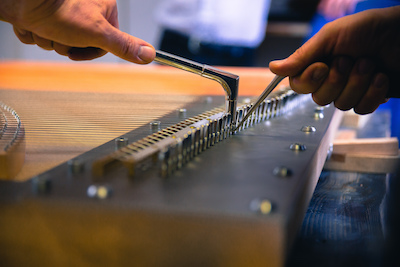Are you ready to buy a piano? Are you debating between new and used? While you might be able to find some “deals” with a little searching, nothing feels the same as bringing a brand new one into your home.
Don’t think of a piano dealer as someone who is merely the middleman between the manufacturer and you. Dealers do a lot more than pulling a piano out of a crate. A lot can happen between where the piano was put together and it’s final resting spot on the dealer’s floor. The dealer ensures it’s brought to full musicality before it makes its way to your home. 
Tuning
Piano parts undergo a lot of stress after being stretched and pulled and placed together. That takes time to adjust. The strings have to stop stretching. The wood has to stop settling. The soundboard has to settle into its new position. That means all of the pieces can quickly cause the piano to fall out of tune. It’s typical for a piano to take up to two years to settle. And that means it can quickly fall out of tune. Dealers will tune it as soon as they set it up on the showroom floor. They also continue to tune it over time, until you make your selection and its moved into your home.
Action
A piano has thousands of moving parts. And most of these parts are a part of the key assembly. Every time a key is pressed and the hammer is released to strike the strings, this performance is known as the action. This process can be stiff as the thousands of tiny parts are brought together for the first time on the manufacturer’s floor. It goes through a break-in period as it adjusts and stabilizes. And it continues as potential buyers consider it sitting on the showroom floor. Dealers monitor that and adjust as settling and environmental changes occur.
Voicing
If you’ve ever played several pianos in succession and noticed that all sound distinctly different, that’s voicing. It’s the tonal quality a piano produces based on the parts used during production. It’s the hardness of the felt; the accuracy of the strings. It’s every part coming together to give the piano its unique personality. That can be adjusted as a piano continue to be broken in. It takes a little adjusting here and a little tweaking there to give it its unique, rich-sounding quality.
Finishing
Of course, the outside has to look as good as the inside. Which is why a dealer will touch up and polish every inch of the piano to ensure it’s in top condition. A lot can happen in a crate as it makes its way hundreds, even thousands of miles from its origination point. And a dealer ensures it’s back up to its original condition.
Are you ready to bring a new piano into your home?

